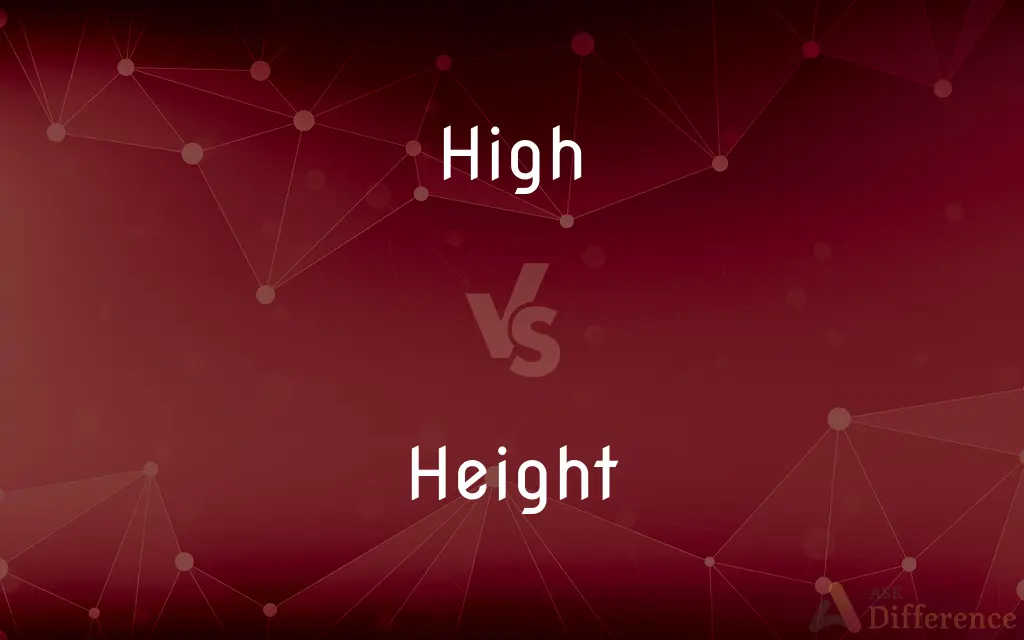High vs. Height — What's the Difference?
By Urooj Arif & Fiza Rafique — Updated on March 5, 2024
"High" describes elevation or extent above a reference point, often used for abstract or literal vertical measurement, while "height" is the specific measurement of an object or point from base to top or from the ground to its highest point.

Difference Between High and Height
Table of Contents
ADVERTISEMENT
Key Differences
"High" is an adjective used to describe something that has a significant elevation or level in relation to a base point or surface. It can be applied in various contexts, from physical objects (like buildings) to more abstract concepts (like temperatures or prices). On the other hand, "height" is a noun that refers to the measurement of an entity's top from its base or the ground, focusing specifically on the dimension of vertical space that it occupies.
When we talk about something being "high," it often conveys a relative sense of elevation or intensity without necessarily specifying a quantitative value. For example, one might say a mountain is high or that interest rates are high, indicating their substantial nature or degree compared to a norm or another reference. Whereas "height" quantifies this vertical extent, providing a specific measurement, such as the height of a mountain in meters or feet, thereby giving a precise dimension.
"High" can also describe the intensity or degree of a particular characteristic, such as high volume, high speed, or high quality, indicating a level above the ordinary or expected. "Height," however, is used in contexts where the vertical dimensions or tallness of an object, person, or point is discussed, focusing strictly on spatial measurements.
The concept of "high" extends into metaphorical or figurative language, where it can describe states of emotion or quality, like high spirits or high standards, suggesting a level of superiority or abundance. "Height," conversely, tends to remain more concrete and specific, rarely straying into metaphorical use, as it denotes the physical extent of vertical distance.
Both terms play crucial roles in various fields, including geography, aviation, architecture, and physics, where "high" might be used to describe altitudes, elevations, or qualitative degrees, and "height" is employed to discuss specific measurements of vertical distances, such as the height of buildings or mountains.
ADVERTISEMENT
Comparison Chart
Part of Speech
Adjective
Noun
Definition
Describes elevation, level, or intensity
Measurement from base to top or ground to point
Contexts
Elevation, intensity, quality
Vertical dimension, tallness
Usage
Relative, often abstract or non-quantitative
Specific, quantitative
Examples
High mountain, high prices
The height of a mountain, the height of a child
Fields
Geography, economics, emotions
Geography, architecture, physics
Figurative Use
Yes (high spirits, high standards)
Rarely
Measurement
Implied or qualitative
Quantitative, specific
Compare with Definitions
High
Describing significant elevation or level.
The plane was flying high above the clouds.
Height
In physics, related to potential energy.
The object’s height affects its potential energy.
High
Indicating intensity or degree.
The meeting was of high importance.
Height
Used in geographical contexts.
The height above sea level is critical for climate study.
High
Reflecting a superior state or quality.
She has high standards for her work.
Height
The measurement of something from base to top.
The height of the building is 50 meters.
High
Relating to abstract concepts.
The interest rates reached a new high.
Height
A specific vertical dimension.
He reached the height of 6 feet in his teens.
High
Used in expressions of emotion.
They were in high spirits after the victory.
Height
Referring to the peak or summit of something.
The climber achieved the height of the mountain.
High
Of great vertical extent
The top of a high mountain
Height
Height is measure of vertical distance, either vertical extent (how "tall" something or someone is) or vertical position (how "high" a point is). For example, "The height of that building is 50 m" or "The height of an airplane in-flight is about 10,000 m".
High
Great, or greater than normal, in quantity, size, or intensity
A high temperature
Sweets are very high in calories
Height
Elevation above a given level, as of the sun or a star above the horizon; altitude.
High
Great in rank, status, or importance
Both held high office under Lloyd George
Financial security is high on your list of priorities
Height
The condition or attribute of being relatively or sufficiently high or tall
Height is an advantage in basketball.
High
Eminent in rank or status
A high official.
Height
The highest or most advanced degree; the zenith
At the height of her career.
High
Standing above others in quality or position;
People in high places
The high priest
Eminent members of the community
Height
The point of highest intensity; the climax
The height of a storm.
High
In or to a high position, amount, or degree;
Prices have gone up far too high
Height
Progress toward eminence; grade; degree.
Social duties are carried to greater heights, and enforced with stronger motives by the principles of our religion.
High
In a rich manner;
He lives high
Height
Natural height of a person or animal in an upright position
High
Far up toward the source;
He lives high up the river
Common Curiosities
What does "high" mean in different contexts?
"High" can describe elevation, intensity, or quality, varying from physical elevation like mountains to abstract concepts like high hopes.
What are examples of "high" in a non-physical sense?
In non-physical contexts, "high" can refer to high temperatures, high prices, or high quality, indicating a level above average or expected.
Can "high" and "height" be used interchangeably?
While related, they're not interchangeable; "high" describes elevation or intensity, whereas "height" refers to the specific measurement of tallness.
How is "height" measured?
"Height" is measured from the bottom to the top of an object or point, usually in units like meters or feet, providing a specific vertical dimension.
How do geography and climatology use "height"?
In geography and climatology, "height" is used to quantify the vertical extent of geographical features, like mountains, or atmospheric layers, providing specific measurements critical for mapping and climate analysis.
How does the use of "high" impact linguistic expression?
"High" enriches linguistic expression by allowing for the description of intensity, elevation, and quality in both literal and figurative contexts, adding depth to communication through its versatile applications.
Is "height" used metaphorically?
"Height" is rarely used metaphorically, primarily denoting physical vertical distances, unlike "high," which has broader figurative applications.
Is "height" applicable in describing human growth?
"Height" is commonly used to describe the vertical measurement of a person, often in reference to growth over time or in comparison to norms or averages for age and gender.
How do "high" and "height" differ in usage?
"High" is more versatile, used both quantitatively and qualitatively across various contexts, while "height" is more specific, usually quantitative, relating to vertical measurements.
How do fields like architecture use these terms?
In architecture, "high" might describe the overall elevation or aesthetic quality of a structure, while "height" would specify its vertical dimensions.
What does "high" convey in emotional contexts?
In emotional contexts, "high" can convey intense or elevated feelings, such as high excitement or being in high spirits.
What role does "high" play in measurements of elevation?
"High" is used to describe the relative elevation of a location or object, indicating its extent above a standard point of reference, such as sea level, without providing a numerical measurement.
Can "high" refer to levels of achievement or status?
Yes, "high" can also denote levels of achievement, status, or rank in various contexts, such as high honor or high office, implying a position above the ordinary or average.
Share Your Discovery

Previous Comparison
Dent vs. Dimple
Next Comparison
Portend vs. PortentAuthor Spotlight
Written by
Urooj ArifUrooj is a skilled content writer at Ask Difference, known for her exceptional ability to simplify complex topics into engaging and informative content. With a passion for research and a flair for clear, concise writing, she consistently delivers articles that resonate with our diverse audience.
Co-written by
Fiza RafiqueFiza Rafique is a skilled content writer at AskDifference.com, where she meticulously refines and enhances written pieces. Drawing from her vast editorial expertise, Fiza ensures clarity, accuracy, and precision in every article. Passionate about language, she continually seeks to elevate the quality of content for readers worldwide.
















































